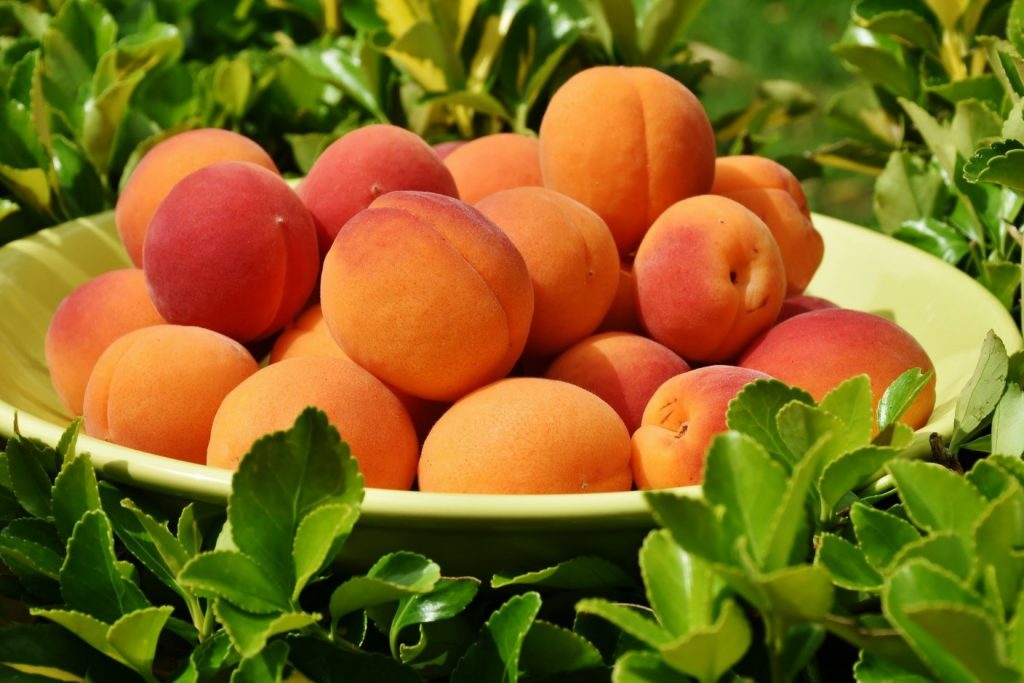The peach industry in Colorado remains mostly a family business. Many growers live and work on orchards surrounding their homes, within communities that include similar farms and families. Often, the fruit in the orchard is a staple of the family’s table. This close proximity is strong motivation to use the safest tools and most up-to-date research to control pests and tree diseases on the farm. Fortunately, peaches are not typically a concern for foodborne illness, however simple precautions should be taken when canning and preserving peache.

Helpful Hints
To remove the peel easily for processing, blanch the peaches for one minute in boiling water and immediately place into an ice bath.
If peaches need to ripen, place them into a closed paper bag at room temperature for a day or two.
Picking the Right Peach
The best time to buy Colorado peaches is between August and September. Choose peaches with fuzzy skins that are firm but yield to gentle pressure. They should be yellow-orange with some red blushing. White peaches should be off-white with a few areas of red blush. Peaches with green tint may not fully ripen. Peaches with blemishes or irregularities, referred to as seconds, are less expensive and good for canning, baking, or making preserves. Avoid using peaches that show signs of spoilage or mold.
Food Preservation Tips
Canning
Select fresh peaches that are firm and use up-to date instructions adjusted for Colorado’s altitude. Check lids the next day to ensure the jars are properly sealed. The lid should be slightly concave and make a ringing high pitched sound when tapped with the bottom of a spoon. Do not eat peaches if the lid is bulging, leaking, or if the peaches have an off odor.
Freezing
Select firm, ripe fruit. Sort, wash, pit and peel. Cut in halves, quarters or slices and dip into anti-darkening solution – 3 tablespoons lemon juice per quart of water.
Peaches can be prepared for freezing using a syrup or sugar pack, or in a crushed or pureed form. Add the recommended amount of ascorbic acid for a better quality product and leave adequate headspace to allow for expansion. For specific information, please see our Freezing Fruits fact sheet.
Peach Jalapeno Jam
3 cups crushed peaches (about 2 lbs, or 4 large peaches)
1/2 cup jalapeno peppers, finely chopped (about 1/4 pound, or 4-5 peppers)
1 cup water
3/4 cup cider vinegar
3/4 cup lemon juice
1 – 1 3/4 oz. package powdered pectin
4 cups sugar
Wash, pit, and crush peaches. Wash peppers, remove stems and seeds, and chop finely. Combine peaches, peppers, water, vinegar, and lemon juice in a 5-6 quart pot. Bring to a boil, then reduce heat and simmer 20 minutes, stirring often to prevent scorching.
Add pectin to the peach/pepper mixture. Bring to a boil over high heat, stirring constantly. Add sugar, stirring well to dissolve completely. Bring to a full rolling boil, stirring constantly. Boil hard for 2 minutes. Remove from heat and skim foam, if needed.
Ladle into sterile, hot, half-pint jars, leaving 1/4-inch headspace. Wipe jar rims with dampened clean paper towel. Adjust two-piece lids. Process in a boiling water bath for 10 minutes at 1000-6000 feet above sea level; 15 minutes above 6000 feet. Yield: 4-5 half-pint jars.
Be sure to wear disposable gloves or thoroughly wash hands after cutting and handling hot peppers such as jalapeño, habanero, and other varieties. Avoid touching the eyes and face while handling peppers. If a severe reaction occurs, flush the skin and site of contact with cool water.
Storage

If peaches are purchased firm, store them on the counter in a brown paper bag to promote ripening. Once peaches become ripe, they should be stored in the fruit drawer of the refrigerator and enjoyed within a few days for best flavor and eating quality. Always wash your peaches with cold water before eating.
Nutrition

Peaches are a healthy addition to any diet. They are cholesterol, saturated fat, and sodium-free, as well as a good source of Vitamin C. Peaches are a great source of fiber and they rank high among other fruits in phytochemicals and antioxidant activity, two substances that may decrease the chances of developing certain types of cancers. Peaches also provide good amounts of potassium and some iron. Although some may be turned off by the fuzzy exterior of the peach, the skin is actually a very good source of beneficial vitamins and minerals.
Peach Facts
Prunus persica (L.) Batsch Rosacea Family
- Peaches originated from China where they were considered a symbol of long life.
- Colorado ranks 6th in peach production in the U.S. There are over 2,400 acres of peach orchards.
- The prime locations for peach growing in Colorado are Mesa, Delta, Montrose, and Montezuma counties.
- Peaches account for over 75% of fruit production in Colorado.
- There are two types of peaches, freestone and clingstone. Freestone peaches are used for the fresh market, whereas clingstone peaches are typically used for canning and processing.


